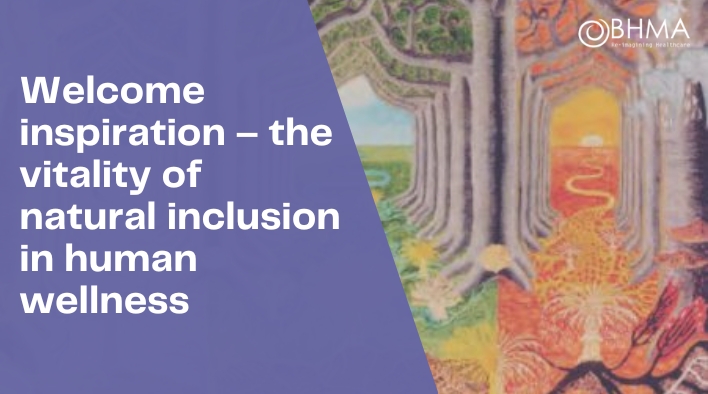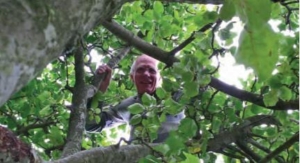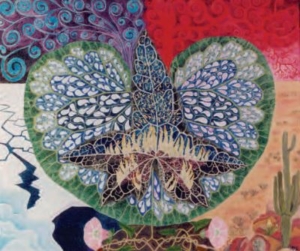Welcome inspiration – the vitality of natural inclusion in human wellness
Alan Rayner, Naturalist
Published in JHH16.1 – Nature Connections
I am an evolutionary ecologist, writer and artist and was a Reader in biological sciences at the University of Bath from 1985 to 2011. Since 2000, I have been pioneering awareness of ‘natural inclusion’, the evolutionary source of all forms of life in receptive-responsive spatial and energetic relationship. My most recent book is The Origin of Life Patterns in the Natural Inclusion of Space in Flux. I love helping people become more aware of the diversity of wildlife in their local neighbourhood.
[bctt tweet=”I only have to ‘behold’ a tree, with the receptive cavity of my heart wide open, to feel its charge” username=”BritishHolistic”]
Introduction
Is it consistent with your experience and does it make consistent (non[1]paradoxical) sense to isolate or conflate yourself from or with your natural surroundings? If not, why not?
This was the combination of questions I asked myself, which enabled me to become aware of myself as a dynamic inclusion and expression of nature, not an exception from nature.
Here I am, in my element. I have included myself within the embrace of an apple tree and climbed into its canopy. In the process, I have become aware of the life of the tree and its inhabitants in a way that simply isn’t possible when viewing the tree from a distant standpoint. I feel inspired and uplifted in the same way that I did as a child, climbing trees in an African garden. I know what William Blake meant when he said:
The tree which moves some to tears of joy is in the eyes of others only a green thing which stands in the way. Some see nature as all ridicule and deformity…and some scarce see nature at all. But by the eyes of a man of imagination, nature is imagination itself’
This brings out the contrast between two distinctive attitudes of mind:
Objectivistic perception places the observer as ‘subject’ at odds with what is observed as an ‘object’.
Empathic perception appreciates both the observer and what is observed as inhabitants of each other’s worlds.
For thousands of years, a great many of us human beings have been persuading ourselves to think and act in an objectivistic way that contradicts our everyday experience of living as we naturally are in the world as it naturally is. We have imagined ourselves individually and collectively to be a race apart from, and superior to, our natural neighbours and neighbourhood, over which we seek to impose control in order both to enrich our lives and to free ourselves from ill-fortune.
Cultivating our sense of natural inclusion – empathic sensibility
My natural sense comes from a feeling of being in empathic rapport with whatever and whoever is present in my vicinity. This goes far deeper than the purely material connection and interaction of discrete objects envisaged by atomistic physics or the unification into oneness of philosophical monism. Instead I have a heartfelt sense of simultaneously welcoming and being welcomed into the other’s world, accompanied by a reciprocal flux of energy betwixt us. It is both exhilarating and calming, as in the meeting and opening of lips in a kiss, X, with a loved one or the coalescence of two adjacent water droplets on a water-repellent surface as they simultaneously release their individual boundary tension and flow into each other’s worlds. I feel the pulse and circulation of the other within my own pulse and circulation and my self-identity is lit up, not annihilated, by it, as illustrated in this delightful image overleaf, prepared by my friend, Roy Reynolds.
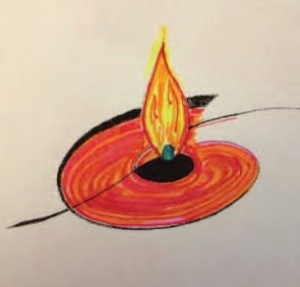 I have this feeling of empathic rapport often when I am in the diverse, unpretentious company of natural wildlife, landscape and waterscape. I don’t even have to be in direct physical contact with the other to get it: I only have to ‘behold’ a tree, with the receptive cavity of my heart wide open, to feel its charge. But I find this feeling dissipates all too readily when in human company, organisations and structures that either ignore me or treat me as an object that is required either to fit in with their prescriptive requirements or be outcast. Does this sound familiar to you or am I alone in feeling this way?
I have this feeling of empathic rapport often when I am in the diverse, unpretentious company of natural wildlife, landscape and waterscape. I don’t even have to be in direct physical contact with the other to get it: I only have to ‘behold’ a tree, with the receptive cavity of my heart wide open, to feel its charge. But I find this feeling dissipates all too readily when in human company, organisations and structures that either ignore me or treat me as an object that is required either to fit in with their prescriptive requirements or be outcast. Does this sound familiar to you or am I alone in feeling this way?
What difference can this natural sense make to the way we understand and live our lives, compared with objectivistic perception, and how can it transcend and transform the latter? To answer these questions it’s important first to understand why objectivistic perception has gained such a powerful grip on our human imagination. What could appear to be its benefits and what could actually be its hidden cost?
From superficial surface To cavernous interior To endless ocean To superficial surface Life flows in cycles and spirals
Immersing us Buoying us Soothing us Exciting us Scaring us As we live its adventurous Path
Between pools and rapids Paddling our own canoes Imagining we hold our destiny In our own hands When, quite clearly, We don’t
Swallowing life hole Makes us well Opposing life’s current Makes it a bitter pill To swallow
Notice how far this simple account of the dynamic natural origin of bodily form has departed from objectivistic perceptions of measurable distance, duration and definitive limits. As my friend, Phil Innes, has put it, ‘time doesn’t stop to have an “event” and space doesn’t stop to have an “object.
Space is what makes natural forms possible, not what isolates them
Boundaries are what make natural forms distinguishable, not what define them
Space is hence understood in essence as a truly infinite, continuous, intangible presence. Time in essence is under[1]stood as intangible energetic flux or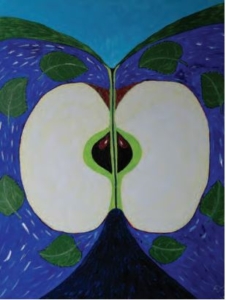 ‘current’. Bodily boundaries are understood to be formed, from subatomic scale upwards, from current circulating around unique localities of space, not rigid demarcation.
‘current’. Bodily boundaries are understood to be formed, from subatomic scale upwards, from current circulating around unique localities of space, not rigid demarcation.
Clock-time’ and ‘ruler-distance’, on the other hand, are scale-independent, abstract quantitative derivations from natural space and time as continuous qualities of nature. Useful as these measurements may be for mapping reality, they are not the reality itself, as is evident, for example, from the findings underlying quantum and relativity theory.
From abstract exclusion to natural inclusion as a guiding principle
Objectivistic thought simply ignores the presence of infinite receptive space, intrinsic energetic flux and the natural inclusion of each of these presences in the other to co-create material form. By so doing, it seeks to capture the infinite receptive expanse of space within a three[1]dimensional frame, and to construct all form from dimensionless points into breadthless lines, depthless planes and solid figures. This has the effect of mentally isolating the identity of ‘self’ and ‘other’ from one another and their surroundings, causing conflict, misunderstanding and distress.
We find solace and joy in the natural companionship of loving and helping each other
To regain our natural sense of reality, all that is fundamentally needed is the feeling and imaginative awareness that our bodies are dynamic inclusions and expressions of nature, not definitively set apart from nature. Quite simply, we can recognise that no bodily content can actually be abstracted from its spatial and energetic context – its natural neighbourhood – and continue to exist.
This awareness of natural inclusion provides us with a compassionate navigational aid, using our cavity at heart as compass, which helps us to recognise and avoid the problems and falsehoods that arise from abstract perception. Our understanding and appreciation of one another and our surroundings shifts profoundly from subjective or objective isolation to naturally inclusive communion. We can no longer envisage or treat ourselves as individually or collectively estranged from one another and our environmental surroundings.
Gone now is the acute sense of loneliness and responsibility that comes with belief in individual or group autonomy, desirous of and exulting in competitive success, while fearful of and despairing in failure. Knowing ourselves to be as we truly are – vulnerable, needful, diverse manifestations of natural energy flow, not purpose-built mechanical objects – compassion can flourish in place of strife and the vain quest for perfection and hierarchical supremacy.
We find solace and joy in the natural companionship of loving and helping each other, even and especially when we fall foul of ‘human error’. Recognising the powerful combined influence of genetic variation and environmental circumstance on our bodily composition and perceptions, we are quick to forgive, slow to condemn and willing to admit, learn from and make allowances for our mistakes and disabilities. Rather than seeking conformity in group belonging, we deeply recognise the truth that it ‘takes all kinds to make a world’.
We recognise that individual and collective identity are not incompatible but vital to the life and love of each. We value the co-creativity of female and male in receptive–responsive partnership, not at odds with one another. We accept death as vital to the evolutionary flow of life as a return to Grace, not some ultimate punishment for failure. We worship and nurture life itself as sacred. We recover our sense of enchantment with being alive in a living world and caring for the needs of generations to come.
We come to love our natural neighbours and neighbourhood as we love ourselves, in a deeply heartfelt way that neither precludes nor is precluded by our intellectual awareness of natural space and boundaries. We seek love, not war – while recognising that the needs and demands of life and love by no means free us from pain and challenge. Need I say more? Yes, maybe I do!
Natural connection and communion – ‘flow-networking’
One of the most fundamental problems arising from the abstract perception that space is a source of discontinuity and distance – a measurable gap between objects – is the supposition that it is a barrier to, not a means of, communication. This is why the notion of ‘action at a distance’, which still bedevils our comprehension of gravity, is so problematic. As soon as we appreciate the true nature of space as an intangible presence that invites and offers no resistance to natural energy flow, we begin to recognise space as a receptive source of communicative continuity that is no ‘final frontier’ to Star Trek travellers whatsoever!
This is important because many of us continue to imagine space as something that has to be connected or bridged across by some kind of tangible linkage if there is to be communication between one locality and another, when the truth is that space pools us all intangibly together in natural communion in the first place. In reality, communication between different localities depends on accessing and enveloping space by removing tangible sources of resistance along distributive channels, pipelines and networks, eg river systems, blood systems, nervous systems, plant venation, animal paths and the mycelial systems of fungi illustrated in my painting Fountains of the Forest.
Such ‘flow-networking’ is radically different in character from entrapment in spiders’ webs and fishermen’s nets, whose function is to capture and conserve energy, not pass it on. We don’t have to tie ourselves up in knots to communicate!
From evolutionary stagnation to evolutionary flow – ‘the survival of the fittest to the proliferation of the possible’
Darwin’s description of natural selection as ‘the preservation of favoured races in the struggle for life’ is a direct product of objectivistic thought, which continues to haunt us to this day. It cannot work as an evolutionary mechanism. This is partly because it is a prescription for monoculture and stasis, not innovation, and partly because a future possibility cannot drive – it can only induce a current process. Natural inclusion therefore offers us a much more sensible way to understand evolution as the mutually transforming flow of all forms of life in co-creative, receptive-responsive relationship. This is a communal and improvisational process in which degeneration facilitates regeneration, not a prescriptive one in which death signals extinction. We can hence perceive life as a gift of energy flow, to be received, sustained and passed on in continuous relay, not a competitive struggle.
We can perceive life as a gift of energy flow, not a competitive struggle
Loving error – the art of natural reconciliation
An insidious implication of objectivistic perception and Darwinism is the notion that human frailty is an economically costly condition caused by mechanical failure, which needs to be singled out, fought and eliminated. This continues to pervade much medical practice and public discourse, as for example in the notion of ‘the battle against cancer’ and calls for ‘genetic screening’ to reveal our ‘design faults’.
Twenty years ago, dismayed by this notion, I painted the picture below.
At the time, I called it Loving Error, with the intention of drawing attention to the creative value of ‘deviating from the norm’ through combining rather than opposing complementary perceptions.
It strikes me that we need now more than ever to find ways in which to love and make allowances for each other’s natural capacity for error, instead of seeking to eliminate it. To do this we need to allow nature to be our healing guide and source of solace, not our judge.
There is a way
Between those warring fractions To bring reconciliation
Through recognition of each other’s faults and virtues
As coming from the same deep place
Where creativity comes to life
In loving form
Burning with passion
Cooling with calm
Fire and stillness combining
In endlessly evolving flair
To know this we only have to listen
With deep abiding care
So, why can’t we?
What’s stopping us?
Further reading
- Rayner, A (2018) The vitality of the intangible: crossing the threshold from abstract materialism to natural reality. Human Arenas 1, 9–20.
- Rayner A (2017) Natural inclusion – a new understanding of the evolutionary kinship of all life on Earth. In: McIntyre-Mills J, Room N, Corcoran-Nantes Y (eds) Balancing individualism and collectivism – social and environmental justice, pp 461–470. Berlin/Heidelberg: Springer
- Rayner, A (2017) The origin of life patterns in the natural inclusion of space in flux. Berlin/Heidelberg: Springer.
- Rayner, A (2012) What are natural systems, actually? Advances in System Science and Application 12, 328–347
- Rayner ADM (2011) Natures scope: Unlocking our natural empathy and creativity – an inspiring new way of relating to our natural origins and one another through natural inclusion. Winchester, UK; Washington USA: O Books.
- Rayner AD (2011) Space cannot be cut: why self-identity naturally includes neighbourhood. Integrative Psychological and Behavioural Science 45, 161–184.
- Rayner ADM (2010) Inclusionality and sustainability – attuning with the currency of natural energy flow and how this contrasts with abstract economic rationality. Environmental Economics 1, 98–108.
- Rayner ADM (2004) Inclusionality and the role of place, space and dynamic boundaries in evolutionary processes. Philosophica 73, 51–70.
- Rayner ADM (1998) Fountains of the forest – the interconnectedness between trees and fungi. Mycological Research 102, 1441–1449.
- Rayner ADM (1997). Degrees of freedom – living in dynamic boundaries. London: Imperial College Press.

